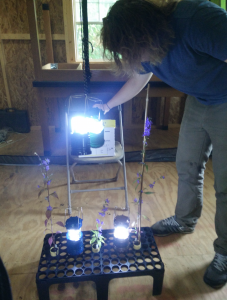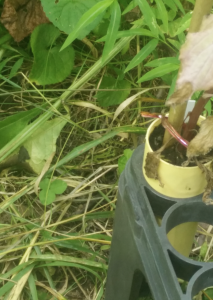Today, Jack and I spent our day out and about. After stopping by the greenhouse to pick-up flowers and drop off Sara (who worked hard all day collecting data for her project), we headed over to our second field site at the Killbuck Wildlife Area. This was just a quick stop to tag flowers from the natural population to use later for the pollinator efficiency project.
After tagging a handful of flowers, we made our way over to Fern Valley, where we (Jack and Dr. Ison) have set up our bumblebee (Bombus impatiens) hive. On Sunday, when Jack and I had last checked on the bees together, the hive hadn’t been doing so well. Unfortunately, many of the bees had died (RIP) and there was little foraging activity. Since then, we have moved the hive outside in the hopes of rebuilding the colony under better conditions.
The bees seemed much livelier today as we saw several individuals entering and exiting the hive. We were not so lucky in terms of training the bees to Campanula, however. We brought the hive back into the tent (flight cage) inside the cabin to train the bees to forage on a few bellflower plants. We left the open hive inside the flight cage for a couple hours while we collected pollinator efficiency data back at Killbuck, but when we returned the bees were largely inactive.

Thankfully, we were much more successful at Killbuck. We collected a lot of data on Ashley’s pollinator efficiency project (visits were received for seed set, pollen removal, and pollen deposition). Meanwhile, Ashley herself was back on campus perfecting her lab techniques!

